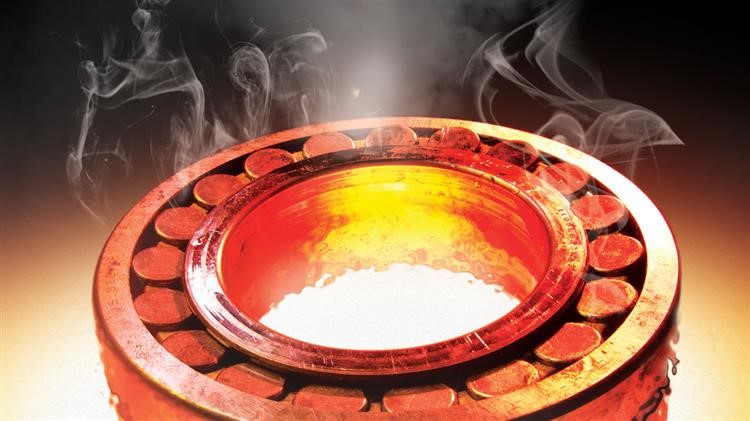Lubrication of bearings at high temperatures using grease

When bearings work under extreme conditions it is important to lubricate them properly to improve their efficiency and life. You must select the right lubricant based on the application and follow the right maintenance procedures.
The most common cause of bearing failure and breakdown is improper lubrication. In high-temperature applications, the bearings get exposed to higher temperatures and you need to use a high-temperature grease for lubrication.
If the right type of grease is not selected then due to high temperature the grease will deteriorate and the volatile component mixed in the grease will evaporate. This will cause the grease to lose its lubricity and become useless.
Conventional grease can withstand temperatures up to 93° C and when the operating temperatures go beyond special grease has to be used. The petroleum-based grease will function well for temperatures up to 121° C continuously and up to 135° C intermittently. Synthetic greases are more stable and work well between 120° C – 160° C.
High-temperature grease
High-temperature grease has an upper-temperature limit and an upper operating temperature. The upper-temperature limit can be defined as the temperature at which the grease can function for a very short period. The upper operating temperature can be defined as the highest temperature at which lubrication can be maintained for a longer period.
Some of the high-temperature greases for bearings are Calcium-Sulfonate complex greases, Lithium EP2 greases and Polyurea greases. These greases can help to extend the life of bearings under high-temperature conditions.
The Calcium-Sulfonate greases have properties like shear stability, high load-carrying capability, water resistance and corrosion inhibition.
The Polyurea grease offers excellent high-temperature performance and has good oxidation resistance. It is suitable for applications where leakage from the bearings occurs due to the high-temperature thinning of grease.
The Lithium EP2 greases can function well in a temperature range of 120° C – 250° C. This grease is used for long-term lubrication of rolling elements and sliding contact bearings at high temperatures. It is best suited for wheel-bearing lubrication in trucks and cars. This grease has properties like good mechanical strength, high thermal resistance, water resistance, good sealing properties against dust and dirt and adheres well.
Advantages of high-temperature greases
- The grease is suitable for long-term lubrication when subjected to high temperatures.
- Using this grease will lead to reduced maintenance and lubricant costs due to safe lubrication.
- The grease will function well over a broad temperature range. The thickener used provides a high dropping point so that it can be used at high temperatures. The base oil used will make it easy for the grease to be pumped in the equipment.
- When you use oil lubricants you have to provide proper sealing. Grease lubrication offers efficient sealing with simple sealing arrangements.
- It has excellent load-carrying capacity and anti-shock performance thus protecting the bearings from wear and extending the life of the equipment.
- The grease has a high base oil viscosity and therefore forms a good oil film thickness even under high-temperature conditions. This helps to protect the bearings from wear.
- It has excellent water and rust corrosion resistance which ensures that the grease stays in place and does not get washed out in wet conditions. It protects the metal surface which leads to longer life of the components.
Selecting a high-temperature grease
- Before you select a high-temperature grease for your application you determine the actual temperature range of the grease. The dropping point of the grease is the temperature at which the thickener loses its capacity to retain the oil. The high temperature of the grease can be obtained by subtracting the nominal temperature from the dropping point.
- Does your application require continuous or intermittent operation? If you need continuous operation then you should select the best grease that meets your requirements.
- Does your application use heating and cooling cycles? Check if moisture will be induced due to the atmosphere or impingement.
- Find out the reasonable relubrication interval. If relubrication is difficult then use a good quality grease to get a lower use cost. Consider if the grease will drip into a component during the process.
- Grease can offer a much longer service than liquid lubricants before relubrication is required. This is important for hard-to-reach components or hazardous locations.
The high-temperature grease should be selected based on the size of the bearing, operating temperature range, motor speeds and maximum loads. You should also consider the amount of moisture ingress and the dust and dirt in the environment. You should select a high-temperature grease for your application with an optimum range of properties.




